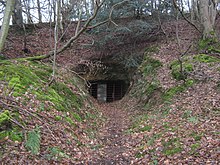| Site of Special Scientific Interest | |
 | |
| Location | Kent |
|---|---|
| Grid reference | TQ 455 529 [1] |
| Interest | Biological |
| Area | 25.4 hectares (63 acres) [1] |
| Notification | 1986 [1] |
| Location map | Magic Map |
Westerham Mines is a 25.4-hectare (63-acre) biological Site of Special Scientific Interest south of Westerham in Kent. [1] [2]
The main interest of this site lies in the use of former mines by five species of bats for hibernation. They are the whiskered, Brandt's, Daubenton's, Natterer's and long-eared bats. Some moths also hibernate in the mines. [3]
There is access to the site, but not the mines which are sealed off by grilles. Many of the structures in the area are made of sandstone and ragstone, which were originally extracted from the mines. Among them, structures are certainly the church in the area. Many tubes in the tunnel complex are only four feet high, and others are much lower due to backfilling. [4]
- ^ a b c d "Designated Sites View: Westerham Mines". Sites of Special Scientific Interest. Natural England. Retrieved 3 March 2018.
- ^ "Map of Westerham Mines". Sites of Special Scientific Interest. Natural England. Retrieved 3 March 2018.
- ^ "Westerham Mines citation" (PDF). Sites of Special Scientific Interest. Natural England. Retrieved 3 March 2018.
- ^ "Westerham Mines | undergroundkent". undergroundkent.co.uk. Retrieved 27 May 2024.
| Site of Special Scientific Interest | |
 | |
| Location | Kent |
|---|---|
| Grid reference | TQ 455 529 [1] |
| Interest | Biological |
| Area | 25.4 hectares (63 acres) [1] |
| Notification | 1986 [1] |
| Location map | Magic Map |
Westerham Mines is a 25.4-hectare (63-acre) biological Site of Special Scientific Interest south of Westerham in Kent. [1] [2]
The main interest of this site lies in the use of former mines by five species of bats for hibernation. They are the whiskered, Brandt's, Daubenton's, Natterer's and long-eared bats. Some moths also hibernate in the mines. [3]
There is access to the site, but not the mines which are sealed off by grilles. Many of the structures in the area are made of sandstone and ragstone, which were originally extracted from the mines. Among them, structures are certainly the church in the area. Many tubes in the tunnel complex are only four feet high, and others are much lower due to backfilling. [4]
- ^ a b c d "Designated Sites View: Westerham Mines". Sites of Special Scientific Interest. Natural England. Retrieved 3 March 2018.
- ^ "Map of Westerham Mines". Sites of Special Scientific Interest. Natural England. Retrieved 3 March 2018.
- ^ "Westerham Mines citation" (PDF). Sites of Special Scientific Interest. Natural England. Retrieved 3 March 2018.
- ^ "Westerham Mines | undergroundkent". undergroundkent.co.uk. Retrieved 27 May 2024.